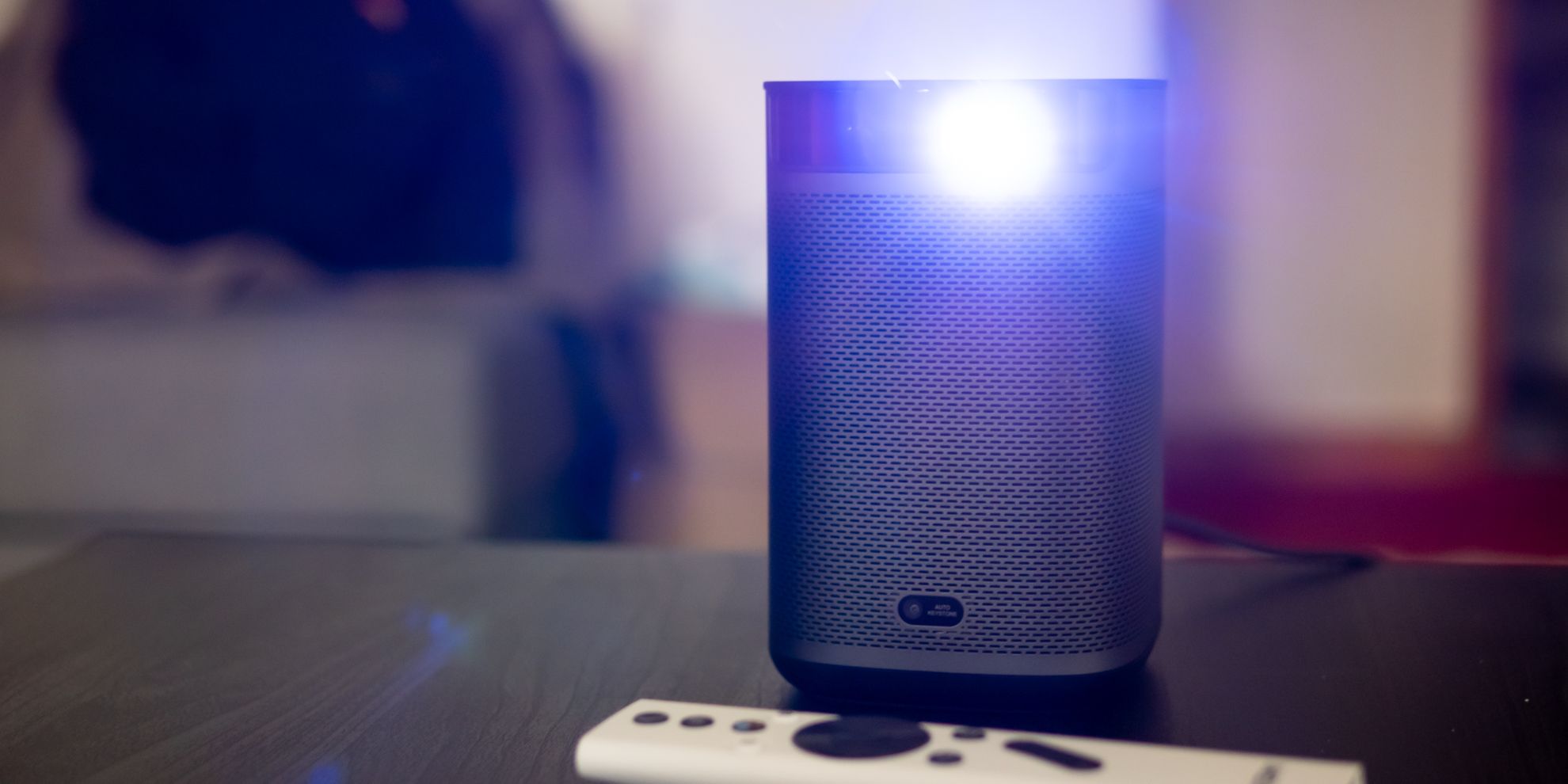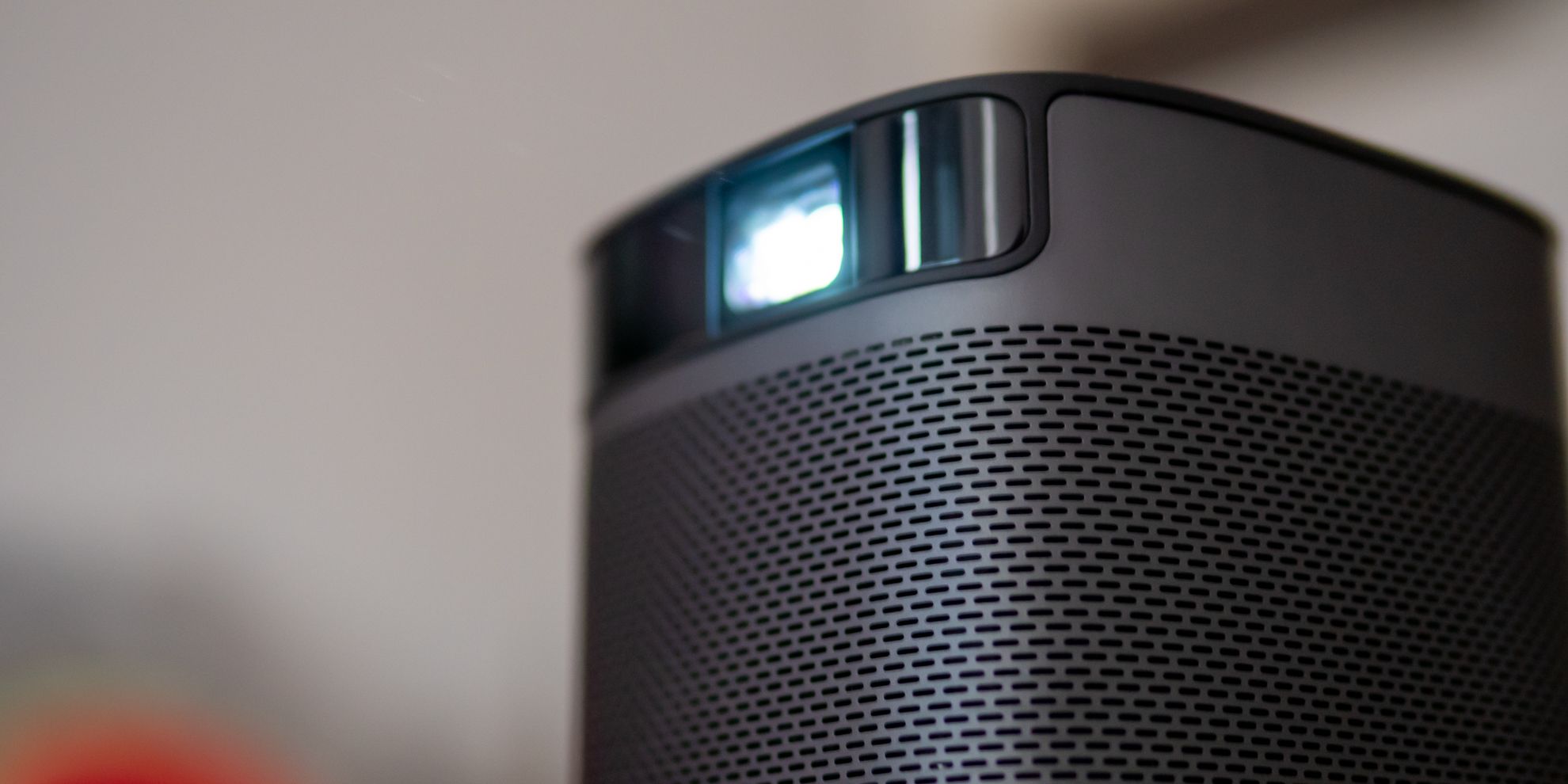If you're in need of a portable projector and have the money to spare, the Xgimi Mogo Pro+ is certainly one of the best in class options. The audio is clear and loud (if perhaps lacking in bass), and the image is bright and true HD. The software experience and ease of use are unrivaled thanks to deep Google integration. Overall, it's an incredibly neat little device. If Netflix or Amazon Prime Video is your main use case though, look elsewhere.
- Brand: Xgimi
- Native Resolution: 1080p
- ANSI Lumens: 300
- Connectivity: HDMI, Bluetooth, Wi-Fi
- Throw Ratio: 1:1
- Audio: Dual 3W Harman Kardon tuned
- OS: Android TV 9.0
- Lamp Life: 30,000 hours
- Runs Google Android TV 9.0, with thousands of apps available
- Snappy interface and easy to navigate
- Chromecast works well
- Full size HDMI input
- Bright enough for massive screens at night
- Battery life is a little short
- Lacklustre bass
- No case included and lens is exposed

The Xgimi Mogo Pro+ is a native 1080p projector with a maximum brightness of 300 ANSI lumens. Running Android TV, it has access to a wide range of apps, as well as a full-size HDMI port if you need it. The audio is tuned by Harman Kardon, and the whole package is rather nifty. But it's not cheap by any means, retailing at around $700.
Buyer Beware with Portable Projectors
The world of portable projectors is fraught with shoddy plastic tat. You'll find countless Amazon listings for small flat rectangles that claim to "support HD" with a brightness similar to any cinema projector that costs ten times the price. Look, here's one, and I've left the brand name in so you know to avoid this company in the future:

2600 lumens, indeed.
What they don't tell you is that it actually projects at a pathetic 480p natively, with about as much luminance as a birthday cake candle—because "lumens" or "lux" is an entirely made-up metric. Instead, you need to look for "ANSI lumens", which is a standardized metric. This is why I'm rather skeptical about approving any review of a portable projector. Thankfully, the Xgimi Mogo Pro+ is not one of those.
Xgimi, unlike other sellers, doesn't lie about the brightness of its projectors. It's about one-tenth the luminance of a similarly priced home cinema projector, and I appreciate the honesty.

Xgimi Mogo Pro+ Design
Measuring 5.8 inches tall, with a rounded 4 inch or so square profile, and weighing just under 2lb or 0.9kg, the Xgimi Mogo Pro+ truly is portable—but there's no carry case included. You should source a suitable protective case if you're taking it out into the wilderness, as the device itself has no ruggedization to speak of. There isn't even a lens cover, which is a little more concerning for something designed to be carried around.
Note: if you purchase from Xgimi's official site, there's a coupon code to get a free case. Our package didn't include this, so we can't comment on it, but worth knowing if you're happy to not buy on Aamzon.
On the underside of the unit is a mechanism you can pull out to tilt the device up to around 45-degrees, and you'll also find a screw thread for attaching to a tripod or other stand (not included).

Around the rear is a single USB port, the DC power socket, an HDMI port, as well as an AUX stereo out. Bluetooth and Wi-Fi round out the connectivity side of things.
Internally, there's an AMLOGIC T950x2 SoC, featuring Mali G31 graphics, 2GB of system RAM, and 16GB onboard storage.

Sofware Experience
Many projectors, portable or otherwise, claim to offer an Android UI, while at the same time only featuring a handful of apps from the Apptoide store.
Again, the Xgimi Mogo Pro+ is not like those. It runs actual Android TV 9.0, and is Google certified.

The included remote even has a button to summon the Google Assistant, and the system is Chromecast compatible, making the process of casting content from your other devices seamless. Anyone who has painful memories of trying to get Miracast to work will certainly appreciate this, and I had no issues casting from either iOS or Android.

In fact, setting up the device was seamless too, with a simple "set up my device" voice command on my phone. It all just worked, which was nice, and avoided having to use an on-screen keyboard on the projector, which is usually awkward and time-consuming on these kinds of devices.
But it's not perfect. Despite offering over 5000 apps in the Google Play store, not all are compatible. Netflix and Amazon Prime, for instance, are not certified for the Xgimi Mogo Pro+. To view those, you'll need to use an external streaming stick. I also found BBC iPlayer was absent from the store, but thankfully that one was easier to solve by simply casting it from my phone.
Auto-Focus and Auto-Keystone
Able to correct for up to 40-degrees of horizontal or vertical angle projection, the auto-keystone and the auto-focus feature worked well, and it kicks in automatically whenever it detects movement. You can disable this if you want, but there's no reason to. A micro-switch on the base of the remote control enables manual focus using the volume keys.
While impressive, it's worth bearing in mind that any kind of keystone adjustment will lead to a sub-optimal image. You can see below the keystone at work in the most extreme example.

The dark grey area of the wall is the potential projection size, distorted because of the placement angle of the projector. The Xgimi Mogo Pro+ successfully corrects for such extreme distortion, but in doing so, wastes half of the available pixels.
For that reason, you should always try to project as orthogonally to the surface as possible. Just because you can put it at weird angles doesn't mean you should.
For those looking to hang the Mogo Pro+ from ceiling, the projection can be rotated, as well as reversed for rear projection.
Throw Ratio and Brightness
As mentioned, the device claims to run at a maximum 300 ANSI lumens of brightness. While I don't have the right equipment to verify the claim, I do have a home cinema projector that runs at 2800 ANSI lumens, and it sounds about right by comparison.
The image below was taken in the daytime, with the curtains closed but still a good amount of ambient light from a side window. At this size (around 120-inches), full brightness isn't quite enough. But at night, it's absolutely sufficient. If you have the space to project from, you can go big.

The throw ratio—which is the relationship between the size of projected image and the distance you place the projector from the surface—works out at about 1:1. Which is to say, if you want a 6-foot diagonal projection, you'll need to place the Xgimi Mogo Pro+ about 6 feet away from the screen.
This isn't technically a "short throw" projector, but nor is it bad at all. But if you want a massive screen in a small space, this isn't for you. Short-throw projectors aren't something you often find in the portable market, so this isn't unusual.
Battery Life
For an extreme test, I fully charged and ran the battery down by streaming live over Wi-Fi, at full brightness and full volume. The battery lasted about an hour and a half before forcefully switching to Eco brightness. At this point, I got another good 15-30 minutes out of it. But I should note that once you hit the low power state, Eco brightness is the only option, and it's not good.
It's impossibly dim in the daytime, and even in darkness, it has a horrible green tint. I would have much preferred to just continue to run the battery down for another 5-10 minutes at full brightness.

90 minutes should therefore be considered a minimum battery life. Turning down the brightness, lowering the volume, and playing back local files with Wi-Fi disabled would all lengthen potential battery life.
Audio Quality
With Harman Kardon on the box, you expect some good quality audio. The laws of physics put a slight damper on that. You simply can't get deep bass from something so small.
The Xgimi Mogo Pro+ definitely gets loud enough for any impromptu movie night without distortion creeping in, and across the rest of the spectrum it sounds clean, crisp, and well balanced. I had no trouble hearing voices, which is ultimately the most important aspect of any projector speaker. I tested with a variety of TV and movie content, and documentaries, and had no complaints about muffled speech.

However, if you're watching explosion-heavy action flicks or gaming with electronic soundtracks, the lack of decent bass becomes more noticeable.
But this isn't hard to fix if it bothers you. Supporting Bluetooth 5.0 or AUX stereo out, you're free to connect your favorite pair of headphones or external speakers for an even better auditory experience.
Repairability and Replacement Parts
While projectors in the past had a costly lamp that would need replacing after around 5,000 hours, modern projectors such as the Xgimi use an LED light source rated to over 30,000 hours. This makes it effectively an end-of-life issue, and cannot easily be replaced. Xgimi doesn't sell replacement parts of any sort.
But to put that in context: even if you watched a 2-hour long movie every day of the year, it would still be 41 years before the LED light source broke.
More likely is that the battery will degrade to the point of being unusable in five to ten years. Of course, you will still be able to run it from AC power, but a built-in battery always reduces the lifetime of a product.
Should You Buy the Xgimi Mogo Pro+?
If you're in need of a portable projector and have the money to spare, the Xgimi Mogo Pro+ is certainly one of the best in class options. The audio is clear and loud (if perhaps lacking in bass), and the image is bright and true HD. The software experience and ease of use are unrivaled thanks to deep Google integration. Overall, it's an incredibly neat little device. If Netflix or Amazon Prime Video is your main use case though, look elsewhere.
That said, I feel like a slightly larger all-in-one package would have served the target audience better. It would have allowed for larger speaker drivers and a slightly larger battery. I also would have liked to see a carry case included, and a lens protector built-in.
Before purchasing, you should also really consider how much you value that portability and the all-in-one design. If you're taking a large AC battery with you anyway, you could purchase a shorter-throw home cinema projector with larger built-in speakers, for around the same price. You'd get a larger screen, ten times the brightness, and better audio. And if sustainability is your primary concern, you should never purchase "all-in-one" products.
